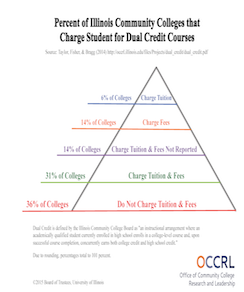On January 9, 2015, President Obama unveiled plans for broadening participation in postsecondary education and forwarding the administration’s college completion agenda. America’s College Promise is President Obama’s proposal to make community colleges free for all students who “make steady progress toward completing their program of study” and maintain a 2.5 GPA. According to the White House, federal funding will cover three-quarters of the average cost of community college attendance while states are expected to cover the remaining costs. Making community college education as universal as K-12 would increase access while addressing issues of affordability that concern many families. Given the escalating costs of a college education, opportunities to extend postsecondary study are timely in a competitive knowledge-based global economy.
Across the U.S., partnerships that increase access and accelerate pathways to college are occurring between secondary schools and community colleges. One such initiative is dual credit programming. While dual enrollment and dual credit are referred to interchangeably in the literature, there are nuances in concurrent programs. In the state of Illinois, dual credit is based on the Illinois Community College Board definition of dual credit as, “An instructional arrangement where an academically qualified student currently enrolled in high school enrolls in a college level course and, upon successful course completion, concurrently earns both college credit and high school credit.” Hence, this includes students enrolled in college courses that are delivered at their respective high schools with their high school teachers; it could also include students taking the courses on campus with a community college faculty and in some instances an online course. As such, the costs of dual credit and who pays varies based on the community college and partnering high schools given the number of secondary teachers that hold a masters degree or have a minimum of 18 hours in the discipline to deliver college credit courses. Notwithstanding the structure of dual credit funding models in Illinois varies widely. Community colleges are often criticized for charging dual credit tuition and fees; however, comparing and contrasting different program models when evaluating dual credit costs shows strata in affordability and access.
OCCRL researchers evaluated dual credit funding models in the state of Illinois releasing a report on dual credit funding (Taylor, Fisher, & Bragg, 2014). Of the 36 institutions responding to the survey, 13 community colleges charge tuition ranging up to $410 per 3-credit hour course and 20 charge fees ranging up to $91 per 3-credit hour course. However, such aggregate information regarding dual credit costs does not tell us which funding designs most effectively promote low-income and underrepresented racial minority student access and participation. In revisiting the survey conducted by Taylor, Fisher, and Bragg (2014), the preponderance of dual credit offering by responding community colleges in Illinois aligns with affording access to accelerated pathways to college. The following infographic demonstrates over one-third of the responding institutions provide free community college tuition and no fees.
Prior studies have shown that there is differential access to dual credit opportunities by income and race/ethnicity (recently noted by OCCRL faculty affiliate Jason Taylor as cited by Marcus, 2015). Although a fair amount of free tuition and no fee based dual credit is available, a considerable number of dual credit opportunities involve tuition and/or fee charges (e.g., courses on campus with college instructors, students are charged full tuition with few exceptions; when courses are offered at the high school by college faculty, students are charged partial to full tuition).
At present, OCCRL researchers are completing a dual credit funding follow-up that explores the effectiveness of dual credit funding, colleges’ efforts to broaden participation, and dual enhancement efforts. This is an exciting time for the study of dual credit as not only a question of tuition and fee policies, but also in terms of program designs and their impact on special populations access and participation. OCCRL is pleased to continue exploring these questions and themes. Please check back for the dual credit funding follow up study research brief in July 2015.
References
- Marcus, J. (2015, May/June). Getting a jump on college: Dual enrollment gives high
schoolers academic momentum. Harvard Education Letter, 31(3), 4-6. - Taylor, J., Fisher, D., & Bragg, D. (2014). Dual credit funding models in Illinois community colleges. Champaign, IL: Office of Community College Research and Leadership, University of Illinois at Urbana-Champaign.
Janice L. North is a graduate research assistant for Dual Credit Funding Models project OCCRL. Janice is passionate about studying the availability and quality of academic programs and student services that impact students’ college access, persistence, and graduation.
Ariana Conner served as an undergraduate assistant for OCCRL. She recently graduated with a bachelor’s degree in news-editorial journalism with a public relations certificate.
